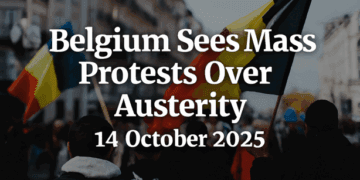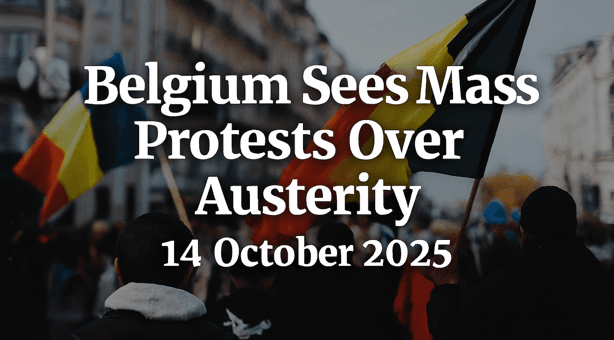On 14 October 2025, the streets of Brussels erupted in one of the largest public demonstrations in recent Belgian history. The Belgium austerity protests 2025 saw over 150,000 people—according to organizers—marching against Prime Minister Bart De Wever’s proposed austerity reforms. Police estimates placed the crowd closer to 80,000, but the scale and intensity of the protest were undeniable.
Background: The Arizona Coalition and Austerity Agenda
Belgium’s new government, formed in February 2025 after seven months of negotiations, is led by Bart De Wever and backed by a five-party coalition dubbed the “Arizona Coalition.” This alliance includes the right-wing New Flemish Alliance (N-VA), the Francophone Reformist Movement (MR), the centrist Les Engagés, the Christian Democratic and Flemish Party (CD&V), and the centre-left Vooruit.
The coalition’s primary mandate is to tackle Belgium’s growing budget deficit. However, the proposed austerity measures—ranging from pension cuts to unemployment benefit caps—have sparked widespread backlash. Critics argue that the reforms disproportionately target low-income workers, women, and vulnerable communities.
Key Demands of Protestors
- Preserve full pension rights and retirement age guarantees
- Protect unemployment benefits and job security for night-shift workers
- Reject labor market reforms that penalize interrupted careers
- Ensure healthcare and social welfare funding remains intact
Scenes from the Streets
Protestors gathered in central Brussels, waving union flags, beating drums, and chanting slogans like “Solidarity, not austerity!” and “We are not the budget’s burden.” Smoke bombs, flares, and banners filled the air as demonstrators blocked major roads and paralyzed traffic. The national strike led to the cancellation of most flights at Brussels Airport and disrupted public transport across the country.
Police Response and Clashes
Belgian police deployed tear gas and water cannons to disperse crowds. Minor scuffles broke out, and several protestors were detained using plastic hand restraints. Officers on bicycles were seen sheltering inside hotels as tensions escalated. Protestors accused police of excessive force, while authorities defended their actions as necessary to maintain public order.
Table: Austerity Measures and Public Impact
| Proposed Reform | Target Group | Public Reaction |
|---|---|---|
| Pension Age Increase | Workers aged 55+ | Strong opposition from unions |
| Unemployment Cap | Long-term unemployed | Criticized as punitive |
| Night-Shift Restrictions | Healthcare and logistics workers | Seen as discriminatory |
| Healthcare Budget Freeze | General population | Feared decline in services |
Union Mobilization and Strategy
Major trade unions including CSC, FGTB, and CGSLB coordinated the protests. Union leaders called for a “national awakening” and warned of continued strikes unless the government reconsiders its austerity agenda. Marie-Hélène Ska, a prominent union figure, stated: “These measures are not reforms—they are regressions. They punish the most vulnerable and reward the wealthy.”
Political Reactions
Prime Minister Bart De Wever defended the reforms, arguing that Belgium’s fiscal health requires “difficult but necessary decisions.” Opposition parties, including the Socialist Party and Ecolo-Groen, condemned the crackdown and called for parliamentary review. King Philippe has remained neutral but is reportedly monitoring the situation closely.
Impact on Daily Life
Public services were severely disrupted. Schools closed early, hospitals operated with skeleton staff, and garbage collection was suspended in several cities. Small businesses reported losses due to reduced foot traffic and supply chain delays. Citizens expressed frustration over the lack of clarity and communication from the government.
Media Coverage and Public Sentiment
Belgian media outlets provided wall-to-wall coverage, with live streams, interviews, and analysis. Social media platforms were flooded with protest footage, solidarity messages, and calls for international attention. Hashtags like #BelgiumProtests and #StopAusterity trended across Europe.
International Reactions
European labor organizations expressed solidarity with Belgian workers. The European Trade Union Confederation (ETUC) issued a statement urging the Belgian government to “respect social dialogue and avoid regressive policies.” French and Dutch unions have hinted at coordinated actions if austerity trends spread regionally.
Historical Context
Belgium has a long history of labor activism, dating back to the 19th century. The 2025 protests echo past movements, including the 2014 pension strikes and the 1993 general strike against welfare cuts. Analysts note that the current unrest is more widespread and digitally amplified than previous episodes.
Voices from the Ground
“I’ve worked night shifts for 12 years. These reforms would cut my pension by 30%,” said a nurse from Liège. “We’re not asking for luxury—just dignity.” A logistics worker from Antwerp added: “They call it reform. We call it betrayal.”
Outlook and Next Steps
Unions have announced a second wave of protests scheduled for 21 October. Parliamentary debates are expected to intensify, with opposition parties demanding amendments and public hearings. The government faces a critical choice: double down on austerity or engage in meaningful dialogue.
Conclusion
The Belgium austerity protests 2025 are a defining moment for the country’s social contract. As workers, unions, and citizens push back against perceived injustice, the government must balance fiscal responsibility with human dignity. The coming weeks will determine whether Belgium moves toward reconciliation or deeper polarization.



















